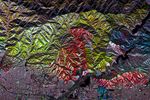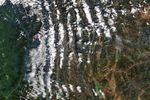BIODIVERSITY & ECOLOGICAL FORECASTING - NASA Carbon Cycle & Ecosystems
←
→
Page content transcription
If your browser does not render page correctly, please read the page content below
S PRING 2021
BIODIVERSITY &
ECOLOGICAL FORECASTING
Funding Opportunities: NASA ROSES 2021 Save the Date:
Research Opportunities in Space and Earth Sciences 2021
The 2021 NASA ROSES announcement was released
Team Meeting
February 12, and contains a solicitation for the Biodiversity The NASA BEF Team
program element: Meeting is scheduled for
October 19-21, 2021,
A.7 BIODIVERSITY: MARINE, FRESHWATER, AND
hopefully in person in the
TERRESTRIAL BIODIVERSITY SURVEY OF THE CAPE Washington, DC area. It will
(BIOSCAPE) AIRBORNE CAMPAIGN SCIENCE TEAM be followed by the MBON
BioSCape seeks proposals to form a science team, led by Drs. meeting on October 22.
Adam Wilson and Erin Hestir, which will engage in six-week
Stay tuned for registration
science flights aboard NASA aircraft over the Greater Cape
information.
Floristic Region (GCFR) of South Africa in late 2023. The three
research themes for the BioSCape campaign are:
a. the distribution and abundance of biodiversity in the Updates Reminder
GCFR, Please send us manuscripts
b. the role of biodiversity in ecosystem functions within that have been accepted to
the GCFR, and journals, preferably after
c. the feedbacks between global change, biodiversity acceptance and well before
change, and ecosystem services in the GCFR. appearance online or in
print.
Sample research objectives are listed on page 7 of the
Scoping Proposal. Proposals must combine information Additionally, let us know of
from at least one of the NASA airborne sensors (PRISM, any awards or recognitions
received from your
AVIRIS-NG, HyTES, and LVIS) with in-situ biodiversity institution or community for
observations. your or your team's
NOIs are due 7/16/2021. Full proposals are due 8/17/2021. research.
Other ROSES-21 calls that may be of interest to our community These updates help us
are Land Cover & Land Use Change, Health & Air Quality, and advertise our program to
SERVIR. Please stay tuned for upcoming Ecological Forecasting the public, administration,
and Terrestrial Ecology calls. and our community.
BIODIVERSITY & ECOLOGICAL FORECASTING PAGE 01Keith Gaddis Becomes a NASA Civil Servant
We are thrilled to congratulate Keith Gaddis on becoming a
NASA civil servant. In his new role, Keith will be splitting cross-
program management responsibilities with Woody Turner as
both a Program Scientist for the NASA Biological Diversity
Program and a Program Manager for the NASA Ecological
Forecasting Program. Keith previously served as the Deputy
Program Scientist for BD&EF.
Keith completed his Ph.D. at UCLA in the Department of Ecology
& Evolutionary Biology. His work used remote sensing and
Keith Gaddis, Ph.D. genetics
. data to answer questions about the effects of
environmental disturbances on natural history and future population viability.
He came to NASA as an AAAS Science and Technology Policy Fellow, in which he consulted on
topics related to biology, specifically in his areas of expertise in combining ecological, genetic,
and evolutionary data to answer new questions. He also managed several inter-agency
collaborations between NASA and the WWF, USGS, and EPA, among others, and worked on
improving the panel review process. In 2020, Keith received NASA's Early Career Public
Achievement Medal.
UN Adopts New System of Natural Capital
Accounting
In March 2021, the 52nd session of the United Nations
Statistical Commission adopted the System of Environmental-
Economic Accounting (SEEA) for ecosystem accounting (EA).
SEEA EA provides a new way to organize data on ecosystem
changes, and will emphasize ecosystem services, which
consist of the benefits the natural world provides, such as
clean air and water. These services have historically been
difficult to quantify, but the framework will use statistics and Chief Economist Elliott Harris
biophysical data to bring them into the calculations when we introduces SEEA at a UN virtual press
balance the benefits of conservation with its costs. conference.
In the words of UN Chief Economist Elliott Harris, "This is a singularly important new
development that will have a major impact. It can and it will be a game changer for the way we
make policy, and it will deeply affect how we think about and tackle climate change and
biodiversity."
The system was developed by Daniel Juhn's team at Conservation International, which
encompasses the use of satellite imagery with field observations to guide conservation efforts.
Concurrently, the CI team is working on an ecosystem condition account using Earth Observations
and field data to support the conservation province of West Papua, Indonesia.
BIODIVERSITY & ECOLOGICAL FORECASTING PAGE 02Upcoming Conferences Available Trainings
ARSET Trainings:
Ecological Society of America Annual Meeting, Introduction to Population Grids and
August 2-6, 2021 | Virtual their Integration with Remote Sensing
Data for Sustainable Development and
International Union for the Conservation of Disaster Management
Nature World Conservation Congress, March 30 & April 6, 2021
September 3-11 2021 | Marseille, France
Satellite Observations and Tools for Fire
World Health Organization Global Conference Risk, Detection, and Analysis
on Health & Climate Change, May 11, 2021
November 6-7, 2021 | Glasgow, UK
DEVELOP Fall 2021
International Congress for Conservation NASA DEVELOP uses Earth Observing
Biology, December 12-16, 2021| Kigali, Rwanda data in interdisciplinary research
projects aimed at addressing
American Geophysical Union Fall Meeting, environmental and public policy issues.
December 13-17, 2021 | New Orleans, Louisiana Currently enrolled students, recent
& Online graduates, and early or transitioning
career professionals are eligible to
apply.
Research Briefs
L E A F RE FL E CTA NCE S PE CTRA CA PTU RE THE E V OL U TIONA RY HIS TORY OF S E E D
PLA NTS
José Eduardo Meireles et al. investigated the correlation
between plant species’ evolutionary relationships and
the spectra of visible light they reflect. The differences
in species’ spectra are caused by variances in particular
genetic traits, which cause the plants to produce
chemical compounds that reflect different patterns of
light. The authors tested whether 544 species of
American and European seed plants could be classified
into their known evolutionary relationships on the basis
of their spectra, and found that this was possible for
broad groups, orders, and families.
This allows future studies to use remotely sensed Correlation of phylogeny and reflectance
spectral data to classify plant lineages and spectra for major seed plant lineages,
relationships, supporting assessments of biodiversity. with larger diameter circles meaning
higher correlation.
BIODIVERSITY & ECOLOGICAL FORECASTING PAGE 03Research Briefs
THE IMPORTA NCE OF INDIGE NOU S PE OPLE S ' LA NDS FOR THE CONS E RV A TION OF
TE RRE S TRIA L MA MMA LS
Christopher J. O’Bryan et al. assessed the overlap
between mapped Indigenous Peoples’ lands, which
make up a quarter of Earth’s surface, and the mapped
habitats of IUCN’s comprehensively assessed list of
terrestrial mammals (4460 species). Using the most
recent global human footprint map to evaluate human
impacts, a large proportion of Indigenous lands were
found to have low levels of human pressure, and offer
refuges to wildlife across the world.
60.4% of all assessed species had at least 10% of
their habitat on Indigenous lands, with 22.6% having
over 50%, marking these lands as critical to
Percentage of species with low, partial,
conservation efforts. These results underline the and complete habitat overlap with
necessity of partnerships with Indigenous Peoples to Indigenous (black) and low-pressure
increase knowledge and maintain biodiversity. Indigenous (gray) lands.
JU S T TE N PE RCE NT OF THE GLOBA L TE RRE S TRIA L PROTE CTE D A RE A NE TWORK
IS S TRU CTU RA LLY CONNE CTE D V IA INTA CT LA ND
Michelle Ward et al. used the 2009 global human
footprint map to quantify connectivity between
protected areas of land around the globe. Pathways
visible at a 1 km^2 scale free of human pressure that
connect protected areas of at least 10 km^2 were
counted for this effort.
The study found that only 9.7% of protected land
worldwide is structurally connected, with a median
connectivity of 0%. Only nine countries have over 17%
of their land protected and maintain over 50%
connectivity; this may be due to more human-
modified countries establishing many small protected
areas surrounded by human-impacted land, rather
than large contiguous areas. These results
underscore the lack of connectivity as a focus for Map of protected areas (blue), non-intact
land (yellow), and intact land (green),
protected area management. illustrating higher connectivity in intact
areas.
BIODIVERSITY & ECOLOGICAL FORECASTING PAGE 04Researcher Profiles
Dr. Stephanie Dutkiewicz Dr. Jie Dai
S E NIOR RE S E A RCH S CIE NTIS T,
POS TDOCTORA L S CHOLA R,
MA S S A CHU S E TTS INS TITU TE
A RIZONA S TA TE U NIV E RS ITY
OF TE CHNOL OG Y
Stephanie Dutkiewicz is a Jie Dai uses remote sensing
Senior Research Scientist at data to study forest biodiversity
MIT in Earth, Atmospheric, and Planetary dynamics of both flora and fauna,
Sciences. She is affiliated with the MIT incorporating both imaging and anthropogenic
Center for Global Change Science, which data for a holistic view of ecosystem change
takes an interdisciplinary approach to over time. For his recently completed doctoral
climate science, and the Darwin Project, dissertation, funded by the NASA Earth and
which brings together ocean science fields Space Science Fellowship, Dai used Landsat
to model marine microbes and their imagery to map the spatial extent of an
communities. Dr. Dutkiewicz develops and invasive vine in the understory of Chitwan,
uses models guided by laboratory, field, and Nepal, a biodiversity hotspot and a frontier of
satellite data to study how ocean chemistry human-environment interactions. Dai
and physics determines phytoplankton investigated the historical green vegetation
biogeography, focusing on how this system dynamics of the forest ecosystem, and then
will be impacted by climate change. In her combined the results with the mapping data to
NASA-funded project, she collaborated with project the future of the invasion and provide
a group of scientists in using high-resolution guidance to combat it, taking into account
imaging to observe nanoplankton dynamics other environmental and anthropogenic
in the North Pacific Ocean, finding a strong inputs.
relationship between net community In his current postdoctoral work at the Arizona
productivity-- how much carbon the State University Global Discovery and
phytoplankton sequester-- and biomass in Conservation Science Center, Dr. Dai works on
these intermediate-sized phytoplankton. Dr. airborne & spaceborne imaging spectroscopy
Dutkiewicz’s modeling showed that this size for biosphere applications, with a particular
class is a particularly important component focus on terrestrial and coastal ecosystems.
of the global marine ecosystem. These Additionally, he reviews, designs, and
results suggest that including phytoplankton develops scientific products for future
size classes may be key in modeling and satellite-based imaging spectroscopy
understanding ocean biological production. missions.
Biodiversity & Ecological Forecasting Team
Woody Turner | Program Scientist & Manager
Keith Gaddis | Program Scientist
Maury Estes | Program Associate, Marshall Space Flight Center
Laura Rogers | Program Associate, Langley Research Center
Cindy Schmidt | Program Associate, Ames Research Center
Maya V. Mishra | Intern
BIODIVERSITY & ECOLOGICAL FORECASTING PAGE 05Recent Publications
Andruszkiewicz, E.A., Yamahara, K.M., Closek, C.J. and Boehm, A.B., 2020. Quantitative PCR assays
to detect whales, rockfish, and common murre environmental DNA in marine water samples of the
Northeastern Pacific. Plos one, 15(12), p.e0242689.
Antao, T., Cosart, T., Trethewey, B., Waples, R.S., Ackerman, M.W., Luikart, G. and Hand, B.K., 2020.
AgeStrucNb: Software for Simulating and Detecting Changes in the Effective Number of Breeders (N b).
Journal of Heredity, 111(5), pp.491-497.
Arostegui, M.C., Braun, C.D., Woodworth-Jefcoats, P.A., Kobayashi, D.R. and Gaube, P., 2020.
Spatiotemporal segregation of ocean sunfish species (Molidae) in the eastern North Pacific. Marine
Ecology Progress Series, 654, pp.109-125.
Bardou, R., Parker, J.D., Feller, I.C. and Cavanaugh, K.C., 2020. Variability in the fundamental versus
realized niches of North American mangroves. Journal of Biogeography.
Bluhm, B. A., Janout, M. A., Danielson, S. L., Ellingsen, I., Gavrilo, M., Grebmeier, J. M., Hopcroft, R. R.,
Iken, K. B., Ingvaldsen, R. B., Jørgensen, L. L., Kosobokova, K. N., Kwok, R., Polyakov, I. V., Renaud, P. E.,
Carmack, E. C. 2020.The Pan-Arctic Continental Slope: Sharp Gradients of Physical Processes Affect
Pelagic and Benthic Ecosystems, Frontiers in Marine Science, 7:886, DOI=10.3389/fmars.2020.544386
Dai, J., Roberts, D.A., Stow, D.A., An, L., Hall, S.J., Yabiku, S.T. and Phaedon, C.
Kyriakidis. "Mapping understory invasive plant species with field and remotely sensed data in Chitwan,
Nepal." Remote Sensing of Environment 250 (2020): 112037.
Devaney, J.L., Pullen, J., Feller, I.C. and Parker, J.D., 2020. Low humidity and hypersalinity reduce
cold tolerance in mangroves. Estuarine, Coastal and Shelf Science, p.107015.
Ditmer, M.A., Iannarilli, F., Tri, A.N., Garshelis, D.L. and Carter, N.H., Artificial night light helps account
for observer bias in citizen science monitoring of an expanding large mammal population. Journal of
Animal Ecology.
Ditmer, M.A., Stoner, D.C., Francis, C.D., Barber, J.R., Forester, J.D., Choate, D.M., Ironside, K.E.,
Longshore, K.M., Hersey, K.R., Larsen, R.T. and McMillan, B.R., 2020. Artificial nightlight alters the
predator–prey dynamics of an apex carnivore. Ecography.
Domínguez, R., Olabarria, C., Woodin, S.A., Wethey, D.S., Peteiro, L.G., Macho, G. and Vázquez, E.,
2020. Contrasting responsiveness of four ecologically and economically important bivalves to simulated
heat waves. Marine Environmental Research, p.105229.
Forget, G., IndividualDisplacements: a Julia package to simulate and study particle displacements
within the climate system.
Goes, J. I., Tian, H., Gomes, H. do. R., Anderson, O. R., Al-Hashimi, K., deRada, S., Luo, H., Al-Kharusi,
L., Al-Azri, A., Martinson, D. G. (2020) Ecosystem State Change in the Arabian Sea fueled by loss of snow
over the Himalayan-Tibetan Plateau region, Scientific Reports. 10:7422 https://doi.org/10.1038/s41598-
020-64360-2
Gomes, H. do R., J. I. Goes, K. Al-Hashimi, L. Al-Kharusi (2020) Global Distribution and Range
Expansion of Green Vs Red Noctiluca Scintillans. In: Dinoflagellates: Morphology, Life History, and
Ecological Significance, Ed. D. Subba Rao, Nova Publishers. Chapter 14, 499-527. Nova Publishers, Inc.,
New York, LCCN 2020017348(ebook)|ISBN 9781536178883
Greene, A., Donahue, M. J., Caldwell, J. M., Heron S. F., Geiger, E., Raymundo L. J. 2020. Coral
Disease Time Series Highlight Size-Dependent Risk and Other Drivers of White Syndrome in a Multi-Species
Model. Frontiers in Marine Science, 7:1022, DOI=10.3389/fmars.2020.601469.
Hansen, A.J., Burns, P., Ervin, J., Goetz, S.J., Hansen, M., Venter, O., Watson, J.E., Jantz, P.A., Virnig,
A.L., Barnett, K. and Pillay, R., 2020. A policy-driven framework for conserving the best of Earth’s remaining
moist tropical forests. Nature Ecology & Evolution, pp.1-8.
Jarzyna, M.A., Quintero, I. and Jetz, W., 2020. Global functional and phylogenetic structure of avian
assemblages across elevation and latitude. Ecology Letters.
BIODIVERSITY & ECOLOGICAL FORECASTING PAGE 06Recent Publications
Juranek, L.W., White, A.E., Dugenne, M., Henderikx Freitas, F., Dutkiewicz, S., Ribalet, F., Ferrón, S.,
Armbrust, E.V. and Karl, D.M., 2020. The Importance of the Phytoplankton ‘Middle Class’ to Ocean Net
Community Production. Global Biogeochemical Cycles, p.e2020GB006702.
Kass, J. M., Meenan, S. I., Tinoco, N., Burneo, S. F., and Anderson, R. P. Improving area of occupancy
estimates for parapatric species using species distribution models and support vector machines. Ecological
Applications.
Luikart, G., Antao, T., Hand, B.K., Muhlfeld, C.C., Boyer, M.C., Cosart, T., Trethewey, B., Al‐Chockhachy,
R. and Waples, R.S., Detecting population declines via monitoring the effective number of breeders (Nb).
Molecular Ecology Resources.
Meireles, J.E., Cavender‐Bares, J., Townsend, P.A., Ustin, S., Gamon, J.A., Schweiger, A.K.,
Schaepman, M.E., Asner, G.P., Martin, R.E., Singh, A. and Schrodt, F., 2020. Leaf reflectance spectra capture
the evolutionary history of seed plants. New Phytologist, 228(2), pp.485-493.
Mostowy, J., Malca, E., Rasmuson, L., Vásquez-Yeomans, L., Gerard, T., Sosa Cordero, E., Carrillo, L.
and Lamkin, J.T., 2020. Early life ecology of the invasive lionfish (Pterois spp.) in the western Atlantic. Plos
one, 15(12), p.e0243138.
O'Bryan, C.J., Garnett, S.T., Fa, J.E., Leiper, I., Rehbein, J., Fernández‐
Llamazares, A., Jackson, M.V. et al. "The importance of indigenous peoples’ lands for the conservation of
terrestrial mammals." Conservation Biology (2020).
Pendleton, D.E., Holmes, E.E. Redfern, J., and Zhang, J. "Using modelled prey to
predict the distribution of a highly mobile marine mammal." Diversity and Distributions.
Rixen T., Cowie G., Gaye B., Goes J., Gomes H. do R., Hood R. R, Lachkar Z. Schmidt H., Segschneider
J., Singh A. (2020). Reviews and syntheses: Present, past, and future of the oxygen minimum zone in the
northern Indian Ocean. Biogeosciences,17(23):6051--6080.
Shiklomanov, A.N., Dietze, M.C., Fer, I., Viskari, T. and Serbin, S.P., 2020. Cutting out the middleman:
Calibrating and validating a dynamic vegetation model (ED2-PROSPECT5) using remotely sensed surface
reflectance. Geoscientific Model Development Discussions, pp.1-35.
Senzaki, M., Barber, J.R., Phillips, J.N., Carter, N.H., Cooper, C.B., Ditmer, M.A., Fristrup, K.M.,
McClure, C.J., Mennitt, D.J., Tyrrell, L.P. and Vukomanovic, J., 2020. Sensory pollutants alter bird phenology
and fitness across a continent. Nature, pp.1-5.
Simpson, L.T., Cherry, J.A., Smith, R.S. and Feller, I.C., 2020. Mangrove Encroachment Alters
Decomposition Rate in Saltmarsh Through Changes in Litter Quality. Ecosystems, pp.1-15.
Ward, M., Saura, S., Williams, B., Ramírez-Delgado, J.P., Arafeh-Dalmau, N., Allan, J.R., Venter, O.,
Dubois, G. and Watson, J.E., 2020. Just ten percent of the global terrestrial protected area network is
structurally connected via intact land. Nature communications, 11(1), pp.1-10.
Wei, C. and Theuerkauf, S. J. 2021. A Novel Multitemporal Approach for Satellite-Derived Bathymetry
for Coastal Waters of Palau, Journal of Coast Research, DOI: 10.2112/JCOASTRES-D-20-00032.1.
Wei, J., Wang, M., Lee, Z., Briceño, H.O., Yu, X., Jiang, L., Garcia, R., Wang, J., and Luis, K. "Shallow
water bathymetry with multi-spectral satellite ocean color sensors: Leveraging temporal variation in image
data." Remote Sensing of Environment 250 (2020): 112035.
Williams, H.M., Siegrist, J. and Wilson, A.M., 2020. Support for a relationship between demography
and modeled habitat suitability is scale dependent for the purple martin Progne subis. Journal of Animal
Ecology.
Zuckerberg, B., Cohen, J.M., Nunes, L.A., Bernath-Plaisted, J., Clare, J.D.J., Gilbert, N.A., Kozidis, S.S.
et al. "A Review of Overlapping Landscapes: Pseudoreplication or a Red Herring in Landscape Ecology?."
Current Landscape Ecology Reports (2020): 1-9.
BIODIVERSITY & ECOLOGICAL FORECASTING PAGE 07You can also read



























































